Whaley Bridge: What happened to Toddbrook Reservoir's fish?
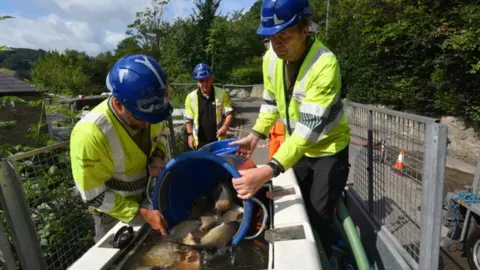 Canal and River Trust
Canal and River TrustMillions of gallons of water were pumped out of Toddbrook Reservoir as emergency services raced to save Whaley Bridge from disaster.
High-volume pumps drained enormous amounts of liquid every hour for a week in a bid to reduce pressure on the dam's spillway.
The operation was ultimately a success, with the wall deemed safe on Thursday afternoon, and hundreds of residents allowed back into the evacuated town.
But what impact has the large-scale pumping had on the reservoir's fish?
Were any fish accidentally pumped out?
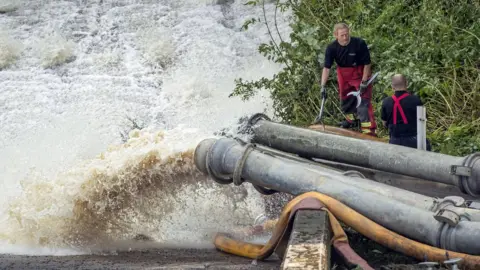 PA Media
PA MediaAccording to the Environment Agency (EA), most fish were likely to have swum away from the noise and disturbance caused by the 23 high-volume pumps that were deployed to drain out the reservoir's water.
"If you speak to fisherman they will say don't thump when you're walking along the bank," said Mark Scott, the agency's area director.
He said the sound of all the pumps "thumping away" would have sent a clear signal to the fish to keep away.
In addition, the pumps used by the fire service had strainers on them which, according to Derbyshire chief fire officer Terry McDermott, would have stopped the fish from getting sucked up.
"The fire service pumps float on the surface, not affecting the fish," he said.
However, naturalist Martin James said: "It's quite possible there would be lots of small fish - or fry - from this year's spawning which would easily be sucked into the pipes."
What kinds of fish are in the reservoir?
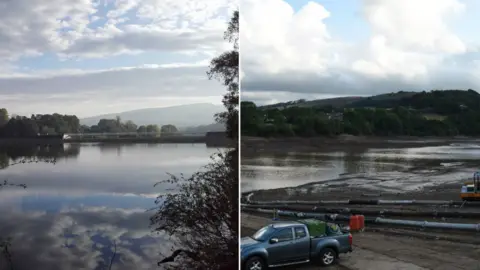 Andy Jones/ Getty
Andy Jones/ GettyUntil the recent crisis, Toddbrook was a popular and quiet angling spot.
Pictures posted online by enthusiasts show a serene body of water with a backdrop of Derbyshire's famous Peak District and tell of impressive fishing exploits.
"It's a beautiful location," said Andrew Bailey, from the Moss Side Social Angling Society (MSSAS), which owns the fishing rights to the reservoir. "You can sit there for a whole day with a few friends and have a bit of a laugh and a fish.
"You can catch bream, roach, perch, tench and chub."
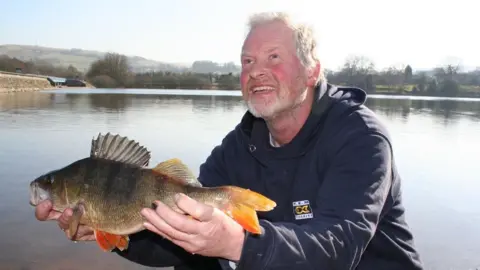 MSSAS
MSSASAmong the fish may be the reservoir's most famous resident: Bertie the barbel fish, a seven-and-a-half pound specimen which was repeatedly caught by the society's members.
"I've caught Bertie once in my life," said Mr Bailey. "We had a few barbel in there a few years ago but Bertie was the sole survivor."
During one of the reservoir's previous drainings, Bertie was caught and transported to nearby Brookfield Pond and was the first resident to return when Toddbrook was refilled.
Alas Bertie has not been seen for about two years but, if he is still swimming in Toddbrook's waters, it is hoped he is safe.
What is happening to the fish now?
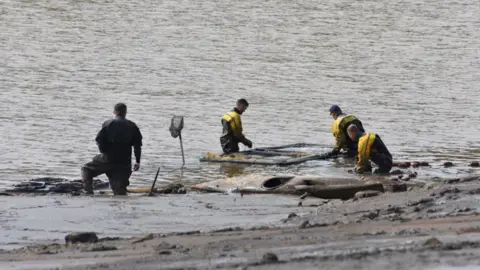 Canal and River Trust
Canal and River TrustThe Canal and River Trust, which owns the reservoir, is carrying out Operation Fish Rescue in conjunction with the Environment Agency.
Teams have been using large seine nets to catch as many fish as possible, then load them into "receiving bins" so they can be transported.
"It's as complicated as having guys in nets with boats," said Mr Scott from the EA.
The receptacles are well-oxygenated to stop the fish getting stressed.
"You've got to be very careful about how you handle those fish because they can lose scales which leaves them open to infection," he said.
The reservoir also contains carnivorous fish such as pike, which need to be transported separately.
It is not known how long the operation will last and some fish may be left in the remaining water.
"It might be that we come back again at a later date when the temperatures are cooler," said Stephen Hardy, from the Canal and River Trust.
Why do the fish need to be moved?
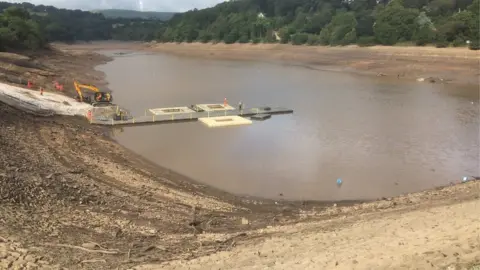 Canal and River Trust
Canal and River TrustAs of Wednesday afternoon, the Environment Agency said the reservoir was about 10% full. There is also more silt in the water than usual.
"A fish breathes through its gills, which are there to pull oxygen out of the water," said the EA's Mr Scott.
"If there is a higher silt loading within the water column that can make it more difficult."
"If there is more organic matter stirred up in the water this can also decrease the available oxygen within it.
"So effectively you've given me less room to swim in and you've made it more difficult to breathe easily, so as a fish I'm becoming less comfortable."
Are the fish in any danger?
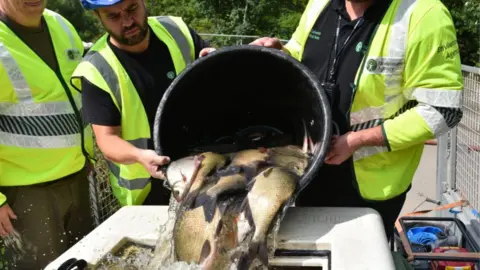 Canal and River Trust
Canal and River TrustThe Environment Agency said teams were "trying to make every effort" to make sure as few fish as possible died or suffered any injury.
Mr James, who has spent 80 years of his life fishing, said: "Fish are quite capable of surviving, to a certain extent, but if a few have to die that's how it must be.
"I'm on the side of people's lives, before anything else."
The EA said it was trying to minimise the environmental impacts of draining the reservoir but added: "We will always put human life first."
"[Teams will] try to rescue as many fish as is practically possible," said Mr Scott.
Where are the fish going?
The reservoir is believed to contain approximately 30,000 fish. As many as possible are being taken to the Bittell Reservoirs in Worcestershire.
This is likely to become their new home, as it is unknown how long the Toddbrook dam repairs are likely to take.
"I suspect we will restock at a later date because we don't know how many months that could take," said Mr Hardy, from the Canal and River Trust.
Will other wildlife be affected?
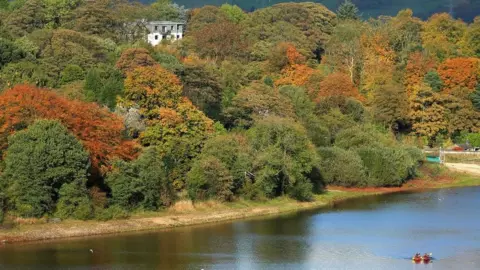 PA Media
PA MediaDerbyshire Wildlife Trust said the reservoir was a Site Of Special Scientific Interest (SSSI), a habitat for herons, ducks and other animals, while rare mosses and liverworts grew on the shores.
Toddbrook been drained twice before - once in the 1970s, when it was empty for seven years.
"It had trees growing on the bottom of it," said angler Andrew Bailey.
The second time occurred in 2010, to allow engineering works to take place on one of the reservoir's valves.
"The reservoir had only just started to fish really well again for the first time since 2010," Mr Bailey said. "It has taken that long to get it re-established."
Conservationist Mr James said the exposure of the reservoir's sides and bed meant invertebrates and insects would die which, in turn, would have an effect on birds such as swifts, swallows, martins, kingfishers and ducks.
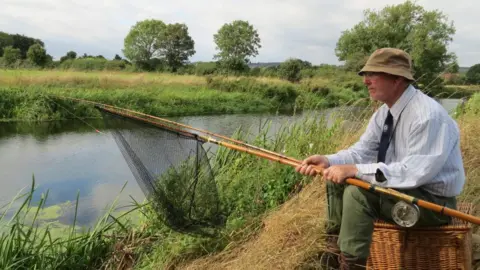 Martin James
Martin James"It's not just fish that are affected," he said. "Birds rely on the huge clouds of flies and midges to feed their young."
Mr Scott said the reservoir environment supported a whole ecosystem, which would change due to it being drained.
"There will be reduction in certain things, but other changes represent an opportunity for other things," he said.
"There's a saying that nature abhors a vacuum. So where certain things move out other things move in.
"It's inevitable that the ecosystem will change but do not necessarily interpret that as being a massive destruction for a long period of time."

Follow BBC East Midlands on Facebook, Twitter, or Instagram. Send your story ideas to [email protected].
